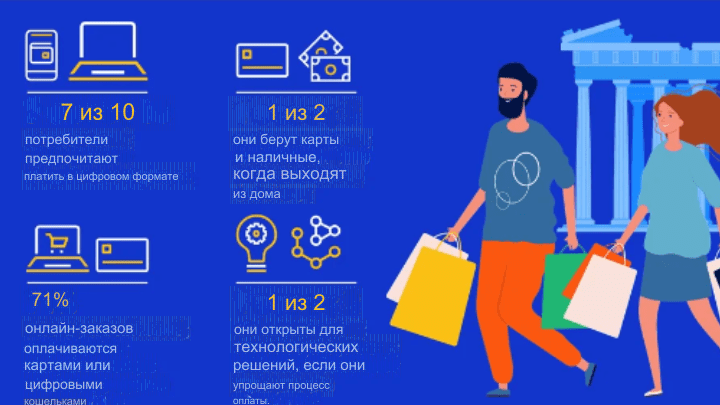Digital payments are becoming the preferred payment method in Greece, a study by Visa and INEMY from ESEE has shown.
Payment by card
Paying by card is an extremely common practice among Greek consumers, with 7 in 10 saying they use cards and digital wallets in their daily transactions. This is the result of a nationwide survey conducted by the Institute of Commerce and Services (INEMY) ESEE on behalf of Visa regarding the digital payments and consumer habits of Greeks.
As already noted, card payments have become particularly widespread and have become more systematic in the everyday lives of consumers. Nearly 65% use cards to a “high” or “very high” degree during their daily shopping trips.
Digital payments appear to have become deeply embedded in the daily lives of Greek consumers, as almost one in two (46%) prefer to carry both cash and cards with them every time they leave home. A notable percentage rely solely on cards (24%), surpassing those who choose cash exclusively (18%). At the same time, 12% prefer to carry a digital wallet with them as their main means of payment. Besides every fourth makes purchases online (from time to time), which proves that Greeks are adopting new trends.
In terms of card use, gender (a person’s sex) does not appear to be a significant differentiating factor – unlike age groups, which show significant differences.
Reducing the use of cash
Greek consumers tend to use cash less, according to a survey. Although they were the main payment method before the pandemic, the situation has changed significantly. In particular Before the pandemic, 48% paid cash “a lot” or “a lot,” but now that percentage is 30.

Low payment amount is main reason for paying in cash for 4 out of 10 participants. Those who gave this answer stated that they did not want to pay small amounts by card because it made them “feel uncomfortable.”
Digital wallets
When it comes to digital wallets, 23% use them “to some extent” for transactions either in physical stores or online. However, the extent of use of digital wallets varies depending on the age group:
- youth 18–34 years old – 33%,
- people 35–54 years old – 25%,
- 55+ – 13%.
And although a significant percentage (29%) said that cash will always be the preferred payment method for Greeks47% are open to new solutions if they make the payment process easier, and 37% say there is a need for further digital education. Nearly one in four (24%) believe that Greeks have adopted digital payments quickly and widely, with particular interest being that 5% would like to know how their purchases impact the environment.
Online shopping
When it comes to online shopping, 43% make purchases online at least once a month. Among people in the 18-34 age group, 57% shop online at least once a month, followed by 35-53 with 51% and 55+ with 26%, respectively. Card payment is the preferred method of online transactions and accounts for 71% of all payments.
In particular, 42% choose to pay by card when placing an order, and 21% upon delivery. The use of digital wallets and other similar payment methods reaches 8%. Cash on delivery is chosen by 25%, while bank deposits have a particularly low rate of 3%. In addition, 3 out of 10 consumers store their card information online. 33% of people aged 18-24 tend to store their card details online, but among people aged 35-54 this figure drops to 25%.
Young people lead purchases on social media
When it comes to purchases made through social media, 20% of people aged 18-34 make them every month. Members of the 35-45 age group buy monthly on social media at a rate of 13%, while the same applies to only 5% of people over 55 years of age.
Valia Aranitou, EKPA Professor of Economic Sociology and Director of INEMY-ESEE, said: “The research shows that there are significant changes in the way we transact today compared to pre-pandemic times. Cards and digital wallets are currently the dominant way Greek consumers pay for purchases. However, this does not mean that cash has disappeared from Greek society. There are three main factors that have a catalytic effect on the use or abandonment of plastic money: age, income and education level. Young people, people with higher levels of education and people with higher incomes are noticeably less likely to choose cash. Regarding gender, there do not appear to be any significant differences. The exception is digital wallet, which seems to be used more by men than women.”







More Stories
Greece: growth in deposits from households and businesses in March 2024
How much will it cost a Greek family to celebrate Easter?
EU employment record: Greece "stuck" in a low position